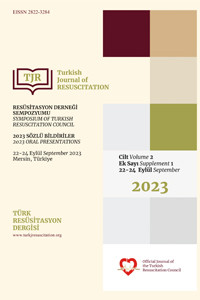Öz
Prediction of neurological outcome after cardiac arrest (CA) is a challenge due to confusing clinical signs caused by treatments, hypoxemia and hypoperfusion. Electroencephalography (EEG) monitoring is critical during postresuscitative care while diagnosing seizure and determination of prognosis. In addition, total spectral power (Ptot) is a quantitative data of an EEG recording which is the sum of the power in each of the frequency bands alpha, beta, delta, theta, sigma and gamma(1). Hypoperfusion and hypoxemia caused by CA and treatments cause less changes in Ptot than EEG.
The aim of this study is determine the role of total spectral power (Ptot) in predicting of neurological outcome after CA.
Anahtar Kelimeler
Kaynakça
- Guilleminault, Christian. Clinical neurophysiology of sleep disorders. Vol. 6. Elsevier Health Sciences, 2005.
Öz
Kardiyak arrest (KA) sonrası nörolojik sonuçların tahmini, tedaviler, hipoksi ve hipoperfüzyonun neden olduğu kafa karıştırıcı klinik belirtiler nedeni ile zorludur. Elektroensefalografi (EEG) monitorizasyonu nöbetlerin tanısının konulmasında ve prognoz tahmininde postresüsitatif bakımda kritik öneme sahiptir. Fakat klinisyenler EEG’nin yorumlanmasındaki tecrübe eksikliğine bağlı ortaya çıkabilecek hatalar nedeniyle kardiak arrest (KA) sonrası EEG kullanımından kaçınmaktadırlar. Ayrıca total spectral power (Ptot) değeri alfa, beta, delta, teta, sigma ve gama frekans bantlarının her birindeki gücün toplamı olan bir EEG kaydının niceliksel bir verisidir(1). KA’in neden olduğu hipoperfüzyon, hipoksemi ve tedaviler Ptot’ta EEG’ye göre daha az değişikliğe neden olur.
Bu çalışmanın amacı kantitatif bir veri olan total spectral power (Ptot) değerinin KA sonrası prognozu belirlemedeki rolünün araştırılmasıdır.
Anahtar Kelimeler
Kaynakça
- Guilleminault, Christian. Clinical neurophysiology of sleep disorders. Vol. 6. Elsevier Health Sciences, 2005.
Ayrıntılar
| Birincil Dil | Türkçe |
|---|---|
| Konular | Anesteziyoloji |
| Bölüm | Bildiri |
| Yazarlar | |
| Yayımlanma Tarihi | 12 Ekim 2023 |
| Yayımlandığı Sayı | Yıl 2023 Cilt: 2 Sayı: S1 - RESÜSİTASYON DERNEĞİ SEMPOZYUMU 2023 SÖZLÜ BİLDİRİLER |

